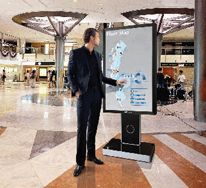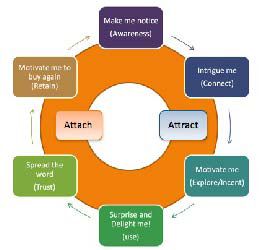Interactive Digital Signs are Here
While most digital signage systems for retail focus on just pushing out ad content, interactive content can be a better way to reach customers at or near the point of sale. Interactive signage, usually involving touchscreens, emulate the web with not just interactivity, but also with the possibility of specific customer tracking. The mobile phone is the ultimate interactive “sign,” and has been on the radar of digital signage for a while — is it coming into the market, finally, as the “remote control” for digital signage?
For some time now, those of us in the digital signage industry have been scratching our heads when it comes to defining an interactive digital sign. Is it a kiosk? A touchscreen? A virtual assistant? All of the above? Or, none of them? Even more confusing, where and how does a mobile phone fit into the equation?
are many experiences that apply.
In-store, screens can be one-way, twoway, or personalized. One-way screens, meaning traditional one-way digital signs, are finally being accepted for their ability to push relevant messaging to shoppers as they move about the store.
Two-way and personalized screens are the natural next step, as they can enable a shopper to do something. And, unlike one-way screens, they can serve as highly measurable “engagement mechanisms.” Due to this, they are experiencing enormous growth, and almost every retailer and brand are looking at how to effectively deploy them to support business growth.
CONNECTING THE MEDIA CONNECTIONS
We often talk about any media as having a role in connecting to people at home, in life, in stores, and at the shelf. However, not often do we talk about the fact that, from the brand perspective, we are trying to not only reach people in these venues, but also move them to do something. After all, brands are not ultimately measured for awareness numbers — they are measured by their sales numbers.
Interactive digital signs exist to help people find some flavor of information. They enable people to move from a mindset of being aware of a need or product to actively taking action to learn more, buy, or provide important feedback. Unlike other media vehicles that push simple awareness, they hold the power to truly stimulate purchase and, if done right, serve a shopper in a way that a good associate might.

Digital signs can provide much more information with a few touches. respond accordingly.
BEST INTERACTIVE SIGNAGE PRACTICES TO EMPLOY AT RETAIL
A friend in the industry once referred to most in-store kiosks as “websites on a stick,” and I agree. Many of them are pushing websites into the store, assuming that busy, time-starved shoppers are going to be excited about dropping what they are doing to dive into a site and mine for whatever they are looking for. This makes no sense whatsoever.
A good interactive screen inside of a store follows the following principles:
• The information it offers is clear and to the point, leaving no guesswork about why it is of use to the shopper.
• It’s identified as for the shopper’s use — many shoppers assume floor technology is for associate use only.
• It’s easy to use, preferably allowing a user to find what they need in three clicks or touches.
• It’s in the right location of the store for shoppers to identify it.
• The content is focused on the category area in which it lives, not trying to offer the entire SKU category for the user to sift through.
• Cross-functional teams that understand the shopper and store needs are behind the project, not just IT folks.
• It’s also be used to empower associates, especially if they are new and need access to information to create a “confidant sale.”
• It’s not annoying anyone with ongoing sound loops or location placement that’s in the way of shopper pathways.
• It’s updated at least seasonally, ensuring that it stays fresh.
• User data is tracked monthly and changes tweaked according to the results.
• Qualitative tests are performed to ensure that the overall use experience is being supported.

This diagram shows how digital signage can both attract viewers and stay with them throughout the marketing process. helpful manner, it’s going to be a win.
WHAT ABOUT MOBILE?
Mobile has huge opportunity both as its own unique digital screen and as a “remote control” for talking to screens around stores. But it’s going to take some time to make it hum within retail stores. Challenges exist in that the carriers aim to charge users for any type of interactivity, many stores have reception issues that require a separate booster for each wireless carrier, and any functional application must be built to work perfectly on every kind of phone out there.
That said, many amazing new mobile plays are now in existence and, as the mobile phone is the ultimate personalized, “pull” mechanism, many powerful camps are motivated to address the challenges sooner than later. But it’s a mistake to think that the mobile phone will be the first interactive digital signage breakthrough. Other technologies are poised to cross the chasm first, and we should not be putting too many eggs in the mobile basket, at least not this year.
Laura Davis-Taylor (laura@retailmediaconsulting.com) is a 15-year agency veteran with a diverse background in traditional advertising, brand planning, interactive marketing, digital signage, merchandising, and retail/environmental design, all geared towards creating consumer-centric solutions for the business challenges of her clients. As founder and principal of Retail Media Consulting (www.retailmediaconsulting. com), her focus is on helping brands strategize and execute powerful media experiences within the store as a marketing vehicle. RMC has just released the first comprehensive guidebook on in-store digital media, and it is available at www.lightinguptheaisle.com
Laura is the yearly chair of the Digital Retailing Expo, an executive member of the POPAI Digital Signage Advocacy Committee, and a lecturer, workshop teacher, and published author in the Marketing at Retail space. She has top 100 brand experience in multiple retail verticals, telecomm, consumer package goods, financial services, and automotive.











